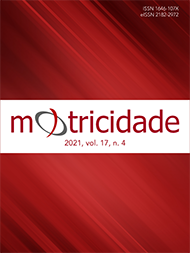Force production and symmetry in water fitness exercises: a gender comparison
DOI:
https://doi.org/10.6063/motricidade.25565Keywords:
aquatic exercise, propulsive force, isometric strength, cadence, sexAbstract
The aim of this study was to analyse and compare propulsive forces, relative force production and symmetry between genders during water fitness exercises. Eighteen participants (women, n= 9; age: 20.67 ± 0.87 years; body mass: 58.18 ± 4.97 kg; height: 159.19 ± 5.85 cm; and men, n= 9; age: 22.11 ± 1.76 years; body mass: 72.93 ± 7.00 kg; height: 170.83 ± 5.57 cm) underwent two incremental protocols performing horizontal adduction (HA) and the rocking horse (RHadd) exercises, from 105 to 150 bpm. Propulsive peak force of dominant (PFD) and non-dominant upper-limbs (PFND) was assessed by a differential pressure system. An isokinetic dynamometer was used to collect the dry-land isometric peak strength of the dominant upper-limb. Significant differences between genders were found for most of the music cadences in HA and RHadd. Men were able to produce higher propulsive force values for both upper-limbs during the overall incremental protocol, whereas women reached a higher relative force production. However, no significant diferences were found between both genders at the same music cadence. Most actions were asymmetric in women, whereas men showed a symmetric pattern. The cadence of 135 bpm elicits a symmetric motion in both genders while exercising water fitness exercises.
Keywords:aquatic exercise; propulsive force; isometric strength; cadence; sex
Downloads
Published
Issue
Section
License
The authors of submitted manuscripts must transfer the full copyright to Journal Motricidade / Sílabas Didáticas Editions. Granting copyright permission allows the publication and dissemination of the article in printed or electronic formats, and copyrights start at the moment the manuscript is accepted for publication. It also allows Journal Motricidade to use and commercialise the article in terms of licensing, lending or selling its content to indexation/abstracts databases and other entities.
According to the terms of the Creative Commons licence, authors may reproduce a reasonable number of copies for personal or professional purposes, but without any economic gain. SHERPA/RoMEO allows authors to post a final digital copy (post-printing version) of the article on their websites or on their institutions' scientific repository.


